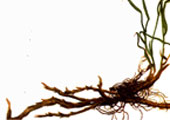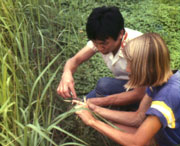
![]()
Search the Journey to Forever website – click HERE
|
Journey to Forever: Make a donation |
Navigation
Contact usTo Keith Addison Handmade Projects |
Quack grass
Aliases: couch grass, dog grass, twitch grass, wheat grass, cough grass, cutch, quitch grass, quake grass, scutch grass, chandler's grass, durfa grass, durfee grass, Dutch grass, Fin's grass, Scotch quelch, devil's grass, witch grass

The accused
Agropyron repens (Beauv.), Triticum repens (Linn.)
Family: N.O. Graminaceae
Distribution: everywhere
Charges: Pernicious and troublesome behaviour, garden terrorism
Prosecution
"One of the worst pests with which the farmer has to contend, taking possession of cultivated ground and crowding out valuable crops." -- "The Herb Hunters Guide" by A.F. Sievers, 1930
http://www.hort.purdue.edu/newcrop/HerbHunters/quackgrass.html
"Quack grass is my totally unwanted weed. The roots are known to aid in kidney diseases, but other plants can do the same and besides, I have enough of this tenacious growth to cure the entire world population of kidney trouble. It is an ongoing struggle that will never end." -- Tina Finneyfrock, "In Defense of Weeds", GardenGuides. She also gives a useful list of what some common weeds are telling you about soil conditions.
http://www.gardenguides.com/articles/weeds.htm
Defence
"My favorite plant that most people consider a weed -- even a noxious weed -- is quackgrass. It is an excellent forage for cattle; it even received some attention from University of Minnesota plant breeders a couple of decades ago; it's drought-resistant, tillage-resistant, and appreciates manure. Interestingly, it is also recognized as allelopathic based on experiments in which root extracts from quackgrass were used to water other plants, which inhibited their growth. In the field, I suspect that any inhibition of other plants is due mainly to the phenomenal spreading root system of quackgrass." -- Jane Grimsbo Jewett, Minnesota Institute for Sustainable Agriculture, University of Minnesota
"Though commonly regarded in this country (UK) as a worthless and troublesome weed, its roots are, however, considered on the Continent to be wholesome food for cattle and horses. In Italy, especially, they are carefully gathered by the peasants and sold in the markets. The roots have a sweet taste, somewhat resembling liquorice, and Withering relates that, dried and ground into meal, bread has been made with them in time of scarcity." -- "A Modern Herbal" by Mrs. M. Grieve, 1931
http://www.botanical.com/botanical/mgmh/g/grasse34.html
"Although a gardener be of another opinion, yet a physician holds half an acre of them to be worth five acres of carrots twice told over." -- "Culpeper -- The Complete Herbal" by Nicholas Culpeper, 1653
"Although that Couch-grasse be an unwelcome guest to fields and gardens, yet his physicke virtues do recompense those hurts; for it openeth the stoppings of the liver and reins without any manifest heat." -- Gerard (quoted in Grieve)
Description
Pernicious weed. Couch grass has a creeping rhizome or underground stem just below the soil surface of the ground, with leaves and roots growing from nodes about an inch apart. Spreads rapidly, and quickly regrows from the smallest piece left in the ground -- very difficult to eradicate, and much more vigorous than most crops. It quickly forms a dense mat of roots that can strangle other plants. Much hated by gardeners and farmers.
Uses -- medicine
In Europe quack grass roots were used until quite recently to make a popular drink to purify the blood. It had many uses in traditional medicine in many cultures, especially for kidney ailments.

A Lantau villager shows Christine Thery how to harvest quack grass to make traditional herbal tea.
The roots are still used by traditional peasants in South China and Hong Kong to make a herbal tonic tea.
The CRC Ethnobotany Desk Reference by Tim Johnson lists couch grass as an anthelmintic, aperient, astringent, demulcent, diuretic, emmenagogue, emollient, sedative, sudorific, and a tonic, used for treating bladder ailments, cancer, congestion, cystitis, depurative, dropsy, gastrointestinal catarrh, gonorrhea, gout, jaundice, kidney irritation, liver ailments, nephritis, orthopedic ailments, painful urination, pyelitis, rheumatic problems, rheumatoid ailments, sclerosis (pylorus), stomach ailments, tumor, urinary ailments, and urinary tract irritation.
Other references cite its use as an antibiotic, antilithic, antimicrobial, antiphlogistic, bladder infection, blood purifier, used to treat Bright's disease, bronchitis, calculi, catarrh, constipation, cystitis, demulcent, depurative, discutient, diuretic, emollient, eyes, female disorders, fevers, gallstones, gout, gravel, jaundice, kidney, lower back pain, pectoral, prostate (enlarged), rheumatism, skin diseases, stones, sudorific, syphilis, tonic, urinary infections.
Other uses
The roots can be dried and ground to flour for making bread, or boiled to make a syrup which can be brewed to make beer. The roasted root is a coffee substitute. Young leaves and shoots are eaten raw in spring salads -- sweet but fibrous. Juice from the shoots is used to make a spring tonic. Seeds can be used as a cereal -- very fibrous. From Plants for a Future database -- which also says couch grass is used to stabilize dunes, can be made into an infusion which is a good liquid plant feed, and that a grey dye is obtained from the roots.
http://www.ibiblio.org/pfaf/cgi-bin/arr_html?Elytrigia+repens
Couch grass is the favourite herbal medicine of dogs and cats, which seek it out and eat large amounts of it. Also liked by cattle, sheep and horses.
Control
Frequent hoeing to keep new shoots down will eventually exhaust the plant and kill it. A good, thick, well-composted and well-watered lawn will smother it, and so will a thick mulch, or a carpet, though it will take time. To control couch grass on a lawn, mow higher -- set the mower to more than 3".
Herbal recipes
From "A Modern Herbal", 1931, by Mrs. M. Grieve
Medicinal Action and Uses -- Diuretic demulcent. Much used in cystitis and the treatment of catarrhal diseases of the bladder. It palliates irritation of the urinary passages and gives relief in cases of gravel. It is also recommended in gout and rheumatism.
It is supposed to owe its diuretic effect to its sugar, and is best given in the form of an infusion, made from 1 oz. to a pint of boiling water, which may be freely used taken in wineglassful doses. A decoction is also made by putting 2 to 4 oz. in a quart of water and reducing down to a pint by boiling. Of the liquid extract 1/2 to 2 teaspoonsful are given in water.
From "Potter's Cyclopaedia of Botanical Drugs and Preparations", by R.C. Wren, F.L.S., Potter & Clarke, London, 2nd Edition.
Part used -- Rhizome (root).
Action -- Diuretic, demulcent, aperient. Used in urinary and bladder complaints, cystitis, nephritis, &c.
Also recommended in gout and rheumatism. The infusion, made from 1 ounce in a pint of boiling water, is taken in wineglassful doses several times daily for feverishness, &c.
Preparation -- Fluid extract: Dose, 1/2-2 drachms.
Distinctive character -- Rhizome slender, tubular, about 1/10-inch in diameter, stiff, shining pale yellow, smooth, with nodes at intervals of about an inch. It is met with in commerce, cut up into short lengths of 1/8 and 1/4 inch, and dried. Taste, slightly sweet. Odour, none.
City farms
Organic gardening
Building a square foot garden
Plant spacing guides
No ground? Use containers
When to sow what
Seeds
Garden pond
Gardening resources
Composting
Making compost
Composting resources
Composting indoors
Vermicomposting
Humanure
Composting for small farms
Small farms
Small farm resources
Community-supported farms
Farming with trees
Farming with animals
Pasture
Pigs for small farms
Poultry for small farms
Aquaculture for small farms
Composting for small farms
Controlling weeds and pests